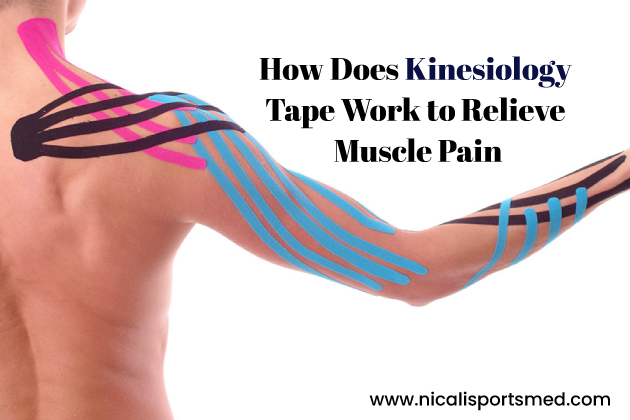Watching sports or fitness events lately, you probably spotted colorful pieces of tape placed on athletes’ muscles above their shoulders, knees, or backs. The unique adhesive strips called kinesiology tape offer real benefits to people with muscle issues and those trying to perform better.
But how does kinesiology tape work? Is the tape’s effectiveness really created by actual science, or is it just magic? Healthcare professionals consistently recommend kinesiology tape, but many ask how its stretchy design creates such powerful results.
This article examines what is K Tape?, and how does KT tape work?, while presenting real benefits of kinesiology tape application.
What is Kinesiology Tape?
We need a proper understanding of kinesiology tape and its main function before studying scientific elements. The K-Tape product features medical-quality adhesive material and elastic cotton threads. Dr. Kenso Kase created a medical tape in the 1970s that bends like skin does when we move.
The design of kinesiology tape strengthens muscles while allowing athletes to maintain a full range of movement during athletic tasks. It’s a versatile tool used in physiotherapy, sports therapy, and rehabilitation to:
- Relieve muscle soreness
- Reduce inflammation
- Improve circulation
- Provide joint support
- K tape supports active athletes with improved results
You may be a casual athlete or a competitive player, yet you likely ask yourself, Does KT Tape work? Is it effective? The data supports that kinesiology tape achieves its therapeutic aims successfully.
How Does Kinesiology Tape Work?
Let’s go straight into details:
1. Lifting Skin Helps Reduce Pain and Swelling Effects
Kinesiology tape stretches the skin, which opens up room between soft tissues and muscle layers. The minimal lift in tissue spaces increases circulation and enables better lymph drainage functions. When blood flows better, it reduces swelling and inflammation to help your body heal faster after injuries and fatigued states.
Like removing a tight sheet, the tape creates cleavage between skin layers to facilitate proper airflow. Skin lifting with K tape results in muscle and joint space that reduces pain and promotes better movement.
2. Supporting Overworked Muscles
Every athlete knows the toll overworked muscles can take. Whether you’ve strained your quadriceps in a strenuous workout or aggravated your shoulder during swim practice, muscle pain can make even simple movements unbearable.
During physical activity, kinesiology tape keeps muscles working properly by making them feel stable. How does physio tape work? K tape fortifies weak muscles that experience tension while shielding from new injuries during rehabilitation.
3. The Tape Helps Train the Brain and Muscles
Kinesiology tape helps stimulate the body’s sensory system to improve how you process pain signals. The tape stimulates skin receptors that shape how your brain processes pain signals. Neuromuscular re-education happens when the body uses K tape to relearn proper pain patterns.
For better understanding, how does kinesiology tape work? Consider this example: applying KT tape to your shoulder injury teaches your brain better pain control methods. The use of KT tape leads to better recovery progress through increased movement confidence.
4. Promoting Natural Healing
What’s in KT Tape that makes it so effective? It’s not about chemicals or medications. K tape works by enhancing your body’s natural processes.
The tape helps muscles stay properly aligned when we move, which lets our body heal more effectively. This supporting system helps patients restore their bodies without needing surgical treatment.
Does KT Tape Actually Work on Muscle Pain?
For many users, kinesiology tape is a life-saver. But how does KT Tape work for different types of pain? Here are three common applications where it shines:
Relief for Acute Injuries
Acute injuries, including sprains and pulled muscles, benefit from kinesiology tape because it decreases swelling while giving mild stabilizing support. Patients can improve their healing time and experience more comfortable feelings because of the tape.
Chronic Pain Management
From lower back pain to tendonitis, k tape is an excellent addition to pain management for chronic conditions. The tape works well to fix pain because it increases blood circulation and eases muscle tension.
Enhanced Athletic Recovery
After exercising, professional athletes typically deal with muscle discomfort. Muscle tape reduces delayed soreness through better lymph circulation, which clears harmful substances from affected areas.
What is the Purpose of Kinesio Tape in Sports?
The real benefits of K tape extend to athletic functions beyond physical healing with added benefits for active sporting activities. By adding muscle support, kinesiology tape allows athletes to perform with greater intensity and experience faster healing. K-Tape gives gym enthusiasts, runners, and swimmers enhanced exercise durability plus protection against injuries.
How to Use Kinesiology Tape Effectively
If you’re new to this muscle-saving marvel, here are some key tips for application:
- Start with Clean Skin: You should stick k tape to bare and entirely dry skin that isn’t treated with oils or lotions.
- Stretch Strategically: The tissue stretch required depends on what your goals are for that area. Flex the tape 10-20% stretch to deliver basic assistance. To achieve more stability, use a stretch rate of 50-75% when applying kinesiology tape.
- Follow the Muscle Lines: Place the k tape flat on muscle alignment areas before making a strong press performance.
- Leave It On: Kinesiology tape remains effective on your skin during shower time and exercise until it naturally falls off in three to five days.
Getting professional sports medicine advice from a physical therapist answers you how does the KT tape work and what is kinesiology tape for.
Why Does K Tape Work Better Than Traditional Tape?
Kinesiology tape supports your body better than athletic tape because it flexes with your movements. This tape helps deliver both stability and movement freedom in active tasks. By providing sensory input, K-Tape enables athletes to recognize their body positions more accurately, which leads to fewer injuries.
What Does Muscle Tape Do for Everyday People?
Anyone can use kinesiology tape to reduce their muscle pain and joint discomfort, regardless of their athletic background. K tape lets you enhance your body position and reduce carpal tunnel discomfort through non-surgical therapy each day.
Start Your Journey to Relief from Pain
K tape serves many essential functions. Your tape partner speeds up your recovery time and boosts your ability to perform while reducing pain for the long term. Kinesiology tape provides a risk-free therapeutic option to aid your recovery needs from injuries while you train for marathons and struggle with persistent back pain.
Work with a licensed chiropractor to experience how kinesiology tape works in your body. You must try this new muscle recovery technology because it has the power to improve your training and healing.

